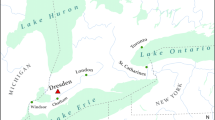Abstract
The Hatshepsut Temple at Luxor, southern Egypt was built as a garden for Amun, and the first court indeed had exotic trees and vegetations. The pathway to the temple was along a sphinx-lined causeway linking the valley to pylons, which are missing now. As an effort to outline remains of the vanished garden and missing pylons and any other possible archaeological structures at this first court site, an extensive integrated magnetic/ground-penetrating radar (GPR) geophysical survey was conducted. The magnetic survey covered the entire area of the first court (100 × 60 m), while the GPR survey covered only an area of 50 × 50 m. The acquired GPR data were processed and presented as 2-D depth sections providing a reasonable vertical/horizontal resolution for the upper 6 m of the investigated site. The acquired magnetic data was processed and presented as 2-D image. The integrated interpretation of the acquired GPR and magnetic data revealed some archaeological features including a rectangular depression which is presumably an ancient man-made pond in the garden of the temple, a rectangular feature that may be a foundation of the missing pylon of the temple, and a suite of aligned anomalies that could be the remnants of sphinx. Such findings reflect the archaeological potentiality of the surveyed site and outline the extension of the temple. Meanwhile, these results necessitate further geophysical investigation or archaeological excavation to be confirmed.







Similar content being viewed by others
References
Abdallatif TF (1998) Magnetic prospection for some archaeological sites in Egypt. Ph D thesis, Faculty of Science, Ain Shams University-Egypt
Aitken MJ (1974) Physics and archaeology, 2nd edn. Oxford University Press, Oxford
Clark JA (1990) Seeing beneath the soil: prospection methods in archaeology. B.T. Batsford, London
El Hosary M (1994) Hydrogeological and hydrochemical studies on Luxor area, southern Egypt: B.Sc. thesis, Faulty of Science, Ain Shams University, Cairo, Egypt
Elbassiony AAA (2001) Geophysical archaeoprospection in Saqqara and Qantir areas, Egypt. Master thesis, Faculty of Science, Ain Shams University
Geoscan Research (1987) Instruction manual version 1.0 (Fluxgate Gradiometer FM9, FM18, FM36). Geoscan Research, Bradford
Ghazala H, El-Mahmoudi AS, Abdallatif TF (2003) Archaeogeophysical study on the site of Tell Toukh El-Qaramous, Sharkia Governorate, East Nile Delta, Egypt. Archaeol Prospect 10:43–55
Kamei H, Atya MA, Abdallatif TF, Mori M, Hemthavy P (2002) Ground-penetrating radar and magnetic survey to the west of Al-Zayyan Temple, Kharga Oasis, Al-Wadi Al-Jadeed (New Valley), Egypt. Archaeol Prospect 9:93–104
Khozym A (2003) Geophysical prospection of some archaeological sites in Saqqara area, Giza, Egypt. Master thesis, Faculty of Science, Ain Shams University
Mertz B (1978) Temples, toms and hieroglyphs: a popular history of ancient Egypt. Dodd, mead and company, New York
Odah H, Abdallatif TF, Hussain AG, (1998) Micromagnetic prospecting to delineate the buried solar boats in Abydos area, Sohag, Egypt, J. Environmental Sciences, Mansoura University, Egypt. 16:121–133
Rodrigues SI, Porsani JL (2006) Utilização do GPR para caracterizar tambores plásticos enterrados no sítio controlado de geofísica rasa do IAG/USP. Revista Brasileira de Geofísica 24:157–168
Rodrigues SI, Porsani JL, Santos VRN, DeBlasis PAD, Giannini PCF (2009) GPR and inductive electromagnetic surveys applied in three coastal sambaqui (shell mounds) archaeological sites in Santa Catarina State, South Brazil. J Archaeol Sci 36:2081–2088
Said R (1981) The geological evolution of the River Nile. Springer, NewYork
Sauck WA, Smart LA, Nassaney MS, Porsani JL (2006) Archaeological geophysics in an urban environment: peeling back the layers at Ft. Miami, Michigan. In: Proceedings of 19th Symposium on the Application of Geophysics to Engineering and Environmental Problems (SAGEEP’2006), April 02–06, Seattle, USA, pp 499–551
Scollar I, Tabbagh A, Hesse A, Herzog I (1990) Archaeological prospecting and remote sensing, topics in remote sensing. Cambridge University Press, Cambridge
Author information
Authors and Affiliations
Corresponding author
Rights and permissions
About this article
Cite this article
Odah, H., Ismail, A., Elhemaly, I. et al. Archaeological exploration using magnetic and GPR methods at the first court of Hatshepsut Temple in Luxor, Egypt. Arab J Geosci 6, 865–871 (2013). https://doi.org/10.1007/s12517-011-0380-x
Received:
Accepted:
Published:
Issue Date:
DOI: https://doi.org/10.1007/s12517-011-0380-x




